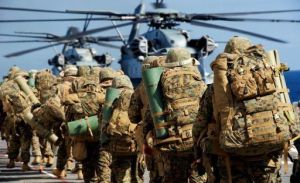
According to reports of various foreign observers, a fairly obvious tension in relations between the two countries has appeared in recent days, despite Washington’s outward declaration of willingness to develop a bilateral cooperation with China in a number of arenas. In the view of many analysts, this is largely due to a shift in US military strategy and its particular emphasis on the strengthening of its strategic presence in the Pacific region as a means of combating Chinese expansion in Asia. The sharpest of these confrontations are in the field of military strategy and of competition for influence over regional economic trade unions. The underlying motive for this is clear: each year 5.3 trillion dollars of the trade turnover takes place in the South China Sea, with US trade accounting for 1.2 trillion of the total amount.
A session of the Subcommittee on Europe, Eurasia and Emerging Threats of the Foreign Affairs Committee of the US House of Representatives termed “China’s Maritime and Other Geographic Threats” held on October 30th, 2013 is a clear indication of the growth of anti-Chinese sentiment in the American political establishment. This session, chaired by Congressman Dana Rohrabacher, witnessed a significant rise in the inciting of military confrontation with China in the Pacific Rim region, as well as a quest by US politicians to further strengthen US expansion in that part of the world by military confrontation with China, looking to Japan for support.
Giving testimony before a congressional subcommittee on February 5th, the US Assistant Secretary of State for East Asian and Pacific Affairs, Daniel Russel, stated that the United States is acting against “China’s incremental efforts to assert control over the area contained in the so-called “nine-dash line” (i.e. China’s territorial demands in the South China Sea)”. He added, “I think it is imperative that we be clear about what we mean when the United States says that we take no position on competing claims to sovereignty over disputed land features in the East China and South China Seas…we do take a strong position that maritime claims must accord with customary international law…”
This assertion, repeated several times during his testimony before Congress and in a briefing for foreign journalists which took place on February 4th in the US Department of State Foreign Press Center, may indicate significant changes in US foreign policy in the Asia-Pacific region. Before Russel’s testimony the United States officially announced its neutrality in respect to maritime disputes in the South China Sea, which was used by American diplomats primarily as a denial of the military component of Washington’s policy in the region. The White House now, however, takes a “strong position” on the issue and intends to use certain provisions of the UN Convention on the Law of the Sea (UNCLOS) – which the US itself has not yet joined – to place increased pressure on China and to denounce Beijing’s maritime demands.
Adjusting for the adoption of its modified position in the Pacific Rim region Washington “aided” the Philippine government in bringing a judicial lawsuit against China before the International Tribunal for the Law of the Sea (ITLOS), which will review the issue on March 30th of this year in Hague. This step, however, is clearly a link in Washington’s coordinated military propaganda campaign against China, as the same day that Russel gave testimony before Congress the New York Times published an interview with president of the Philippines Aquino, in which he compared Beijing’s territorial demands in the South China Sea with Hitler’s 1938 seizure of the Czech Sudetenland, equating China’s activities with those of Nazi Germany. In support of Aquino’s inflammatory comparison, on February 6th of this year The Atlantic temporarily carried an article with a critique of China.
When, with the clear sanction of the White House, the US media begins comparing a country with Nazi Germany, it becomes obvious that the American war machine is gaining momentum in its preparations for the next war, in which military industry circles have long been interested. The “informational support” of such a shift in US foreign policy was provided in the form of speeches delivered by a number of congressmen before congressional subcommittee hearings on maritime disputes, which took place last week. Testimony was brought by congressmen Ami Bera, Steve Chabot, Randy Forbes, Brad Sherman and a number of others in support of a forceful US position and of confrontation with Beijing over disputed territories in the Pacific Rim region.
Meanwhile, an active relocation of the US submarine fleet in the Pacific Ocean is underway, as well as the modernization and expansion of the US military base on Guam, its largest base in the Western Pacific since World War II, although the military equipment there is already sufficient for large-scale military activities, according to a number of military experts. The building of additional military bases on the South Korean Island of Jeju, the Australian Cocos Islands and the expansion of its base on the Diego Garcia Islands is clearly in the Pentagon’s interest. Singapore has already given permission for the use of its Navy base, Chang, for better control over the Malacca Strait, through which 80% of its Chinese oil imports arrive…
Under such circumstances, the true agenda of US vice-president Biden and US Deputy Secretary of State William Burns’ visits to the region becomes increasingly clear, as well as that of the upcoming visits of Secretary of State John Kerry, Minister of Defense Chuck Hagel and a number of other high-level US officials. The US’s political balancing act in the Pacific Rim region is truly shifting.
Vladimir Odintsov, a political observer, exclusively for the online magazine New Eastern Outlook.
